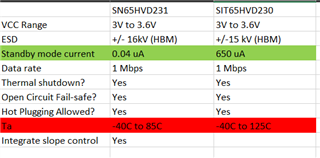Other Parts Discussed in Thread: TCAN1044A-Q1,
Hi team,
Good day!
Question 1: Could you please tell me what's the detailed difference between SN65HVD231 and TCAN1044A-Q1, except for Vcc?
Question 2: Could you please give me a comparison of SN65HVD231 and SIT65HVD230? And what is our TI benefits and disadvantages?
Thanks.
Best Regards
Sophia Zhang



